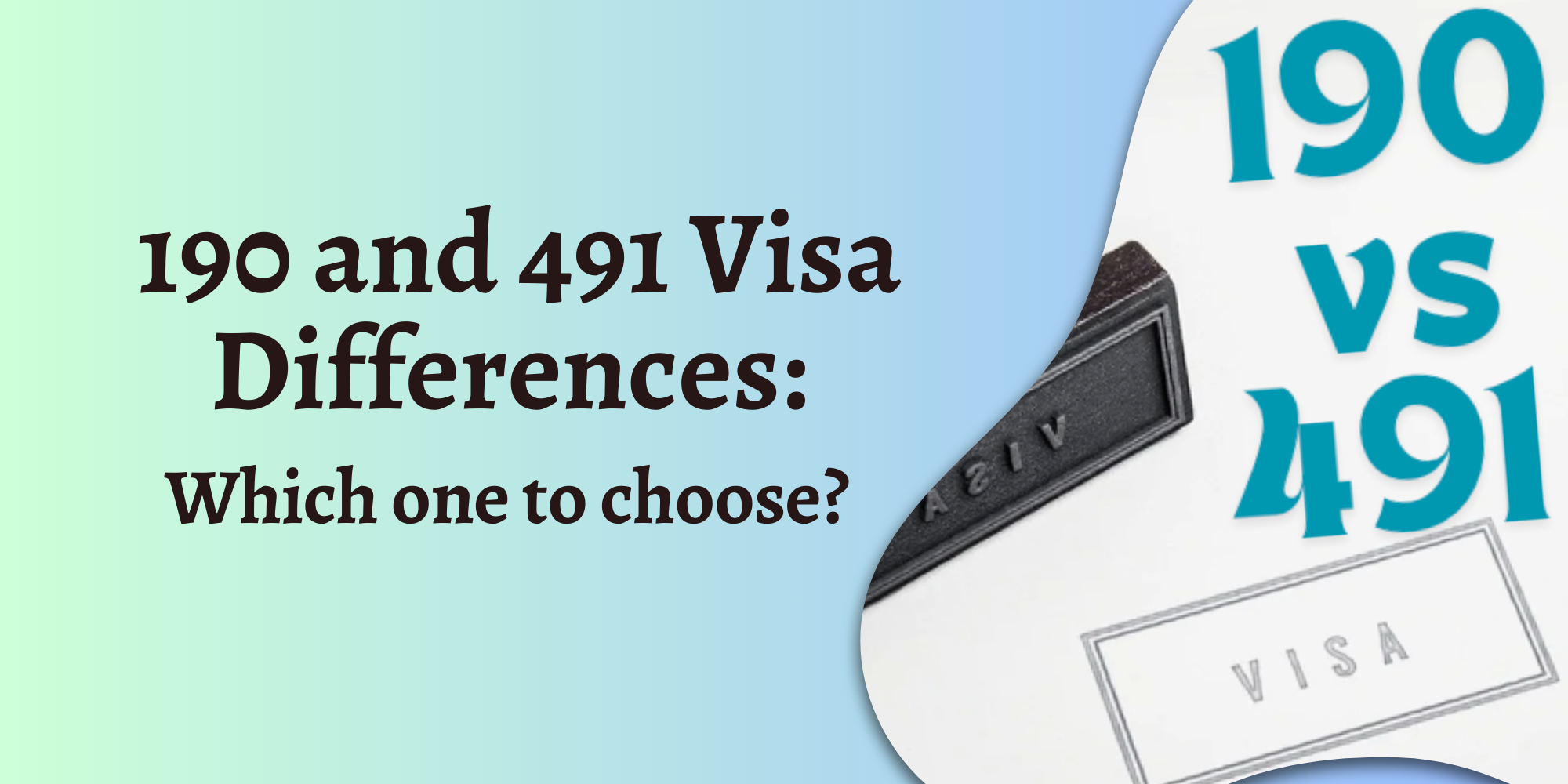Are you considering a move to Australia but unsure which visa option suits you best? The difference between 190 and 491 visas can be crucial in your decision-making process. These visas offer unique pathways to live and work in Australia, each with its own set of benefits and requirements. Understanding what sets them apart is essential to choosing the right option for your circumstances and career goals.
In this article, we’ll break down the key differences between visa 190 and 491. You’ll learn about their eligibility criteria, benefits, and limitations. We’ll also explore the distinction between permanent and provisional status, regional commitments, and the application process for each visa type. By the end, you’ll have a clear picture of how these visas compare, helping you make an informed decision about your Australian immigration journey.
Overview of 190 and 491 Visas
Subclass 190 Visa
The Subclass 190 visa, also known as the Skilled Nominated Visa, is a permanent residency option for skilled workers nominated by an Australian state or territory government. This visa allows you to live, work, and study in Australia indefinitely. To be eligible, you need to have a skill listed on the relevant skilled occupation list and obtain a suitable skills assessment. You’ll also need to submit an Expression of Interest (EOI) through the SkillSelect online service and receive an invitation to apply.
Subclass 491 Visa
The Subclass 491 visa, or Skilled Work Regional (Provisional) Visa, is designed to address skill shortages in regional areas of Australia. This provisional visa is valid for five years and encourages you to live and work in regional or low-population growth metropolitan areas. You can be sponsored by either a state or territory government or a relative living in a designated regional area of Australia. The 491 visa offers a pathway to permanent residency if you meet certain conditions, including living in the regional area for at least three years and maintaining an annual income of AUD 82,980.68.
Key Similarities
Both the Subclass 190 and 491 visas share several important features:
- Points-based system: Your eligibility is determined by factors such as age, English proficiency, skilled employment, and educational qualifications.
- State or territory nomination: Both visas require nomination by an Australian state or territory, aligning your skills with regional needs.
- Skills assessment: You must undergo a skills assessment by an authorized assessing authority to ensure your qualifications meet Australian standards.
- English proficiency: Competency in English is a prerequisite for both visas.
- Age requirement: Applicants must be under 45 years old at the time of invitation.
- Health and character checks: You need to meet medical, health, and character requirements.
- Family inclusion: Both visas allow you to include family members in your application.
- Invitation process: You’ll need to receive an invitation to apply after submitting your EOI.
Eligibility Requirements
To qualify for either the 190 or 491 visa, you need to meet specific criteria set by the Australian government and the nominating state or territory. Let’s break down the eligibility requirements for each visa type and compare their points systems.
| 190 Visa Eligibility | 491 Visa Eligibility |
| Be under 45 years of age at the time of invitation. | Be under 45 years of age at the time of invitation. |
| Secure nomination from an Australian state or territory government. | Obtain sponsorship from a state or territory government or an eligible family member living in a designated regional area. |
| Score at least 65 points on the immigration points test. | Score at least 65 points on the immigration points test. |
| Have your skills assessed by the relevant assessing authority. | Have your skills assessed by the relevant assessing authority. |
| Demonstrate competent English language proficiency. | Demonstrate competent English language proficiency. |
| Have an occupation on the relevant skilled occupation list. | Have an occupation on the relevant skilled occupation list. |
| Meet health and character requirements. | Commit to living and working in a designated regional area for at least three years. |
Points System Comparison
Both visas use a points-based system to assess eligibility. Here’s how they compare:
- Minimum points required: 65 for both visas
- Additional points:
- 190 visa: 5 points for state nomination
- 491 visa: 15 points for state nomination or family sponsorship
The points test considers factors such as age, English language ability, skilled employment experience, and educational qualifications. The extra points for the 491 visa can give applicants a significant advantage in meeting the required threshold.
To apply for either visa, you must submit an Expression of Interest (EOI) through SkillSelect. Your skills assessment and English language test results should have at least 12 weeks of validity remaining when you submit your nomination application.
Benefits and Limitations
Advantages of a 190 Visa
The Subclass 190 visa offers several compelling benefits for skilled workers seeking permanent residency in Australia. As a permanent visa, it allows you to live and work in Australia indefinitely. This means you can enjoy the stability and security of long-term residence without the need for visa renewals.
One of the key advantages is the freedom of movement it provides. While you’re initially required to live in the nominating state or territory for two years, you’re not strictly bound to that region afterward. This flexibility allows you to explore opportunities across Australia once you’ve fulfilled your initial commitment.
The 190 visa also grants you access to Australia’s public healthcare system, Medicare, ensuring you and your family have comprehensive health coverage. Additionally, you’ll have the opportunity to apply for Australian citizenship after meeting the eligibility criteria, which can be as short as one year for some visa holders.

Advantages of 491 Visa
The Subclass 491 visa, while provisional, comes with its own set of benefits. One of the most significant advantages is the additional 15 points it offers towards your overall points score. This can be a game-changer for many applicants, making it easier to meet the minimum point requirement of 65.
The 491 visa opens up opportunities in regional areas, which often have a lower cost of living and less competition for jobs. Many employers in these areas offer competitive salaries and may even provide relocation benefits to attract skilled workers.
This visa also provides a clear pathway to permanent residency. After living in a designated regional area for three years and meeting specific income requirements, you can apply for the Subclass 191 Permanent Residence (Skilled Regional) visa.
Drawbacks to Consider
While both visas have their merits, there are some limitations to consider. The 190 visa, being highly sought after, has a more competitive application process. It typically has fewer eligible occupations and often requires higher English language proficiency or longer work experience.
The 491 visa, while offering more points and potentially easier entry, comes with the requirement to live and work in a designated regional area for at least three years. This commitment might not suit everyone, especially those with career aspirations in major cities. Additionally, as a provisional visa, it doesn’t offer immediate permanent residency, which may affect long-term planning and stability for some applicants.
Permanent vs Provisional Status
190 visa: Immediate permanency
The Subclass 190 visa offers you immediate permanent residency in Australia. This means you can stay in the country indefinitely, giving you a stable and long-term settlement option. With this visa, you have the freedom to live, work, and study anywhere in Australia after fulfilling any initial state or territory obligations.
As a permanent resident, you’ll enjoy several benefits:
- Access to Medicare, Australia’s healthcare system
- Ability to sponsor eligible relatives for permanent residence
- Travel to and from Australia for five years
- Opportunity to apply for Australian citizenship, if eligible
This permanent status allows you to plan for a long-term future in Australia right from the start, providing a sense of security and stability for you and your family.
491 visa: Pathway to Permanency
In contrast, the Subclass 491 visa is a provisional visa valid for 5 years. While it doesn’t offer immediate permanent residency, it provides a structured pathway to achieve it. As a 491 visa holder, you’re required to live, work, and study in a designated regional area of Australia.
The journey to permanency with a 491 visa involves:
- Living in a regional area for at least 3 years
- Meeting specific income requirements
- Applying for the Subclass 191 Permanent Residence (Skilled Regional) visa
After fulfilling these conditions, you can transition to permanent residency, opening up similar benefits to those of the 190 visa holders.
Impact on Long-Term Plans
The difference in visa status can significantly affect your long-term plans in Australia. With the 190 visa, you have the flexibility to make immediate long-term commitments, such as purchasing property or establishing a business anywhere in Australia.
The 491 visa, while offering a clear path to permanency, requires you to commit to regional living for at least three years. This can impact your career choices and lifestyle decisions in the short to medium term. However, it also presents opportunities to experience life in regional Australia, which often offers a lower cost of living and less competition for jobs.

Regional Commitments
190 visa regional obligations
When you receive a Subclass 190 visa, you’re expected to live in the nominating state or territory for a specified period, typically two years. This commitment supports the state’s investment in your skills and helps address local workforce needs. However, it’s important to note that the 190 visa is a permanent visa with no strict conditions attached. Once granted, you have the right to live anywhere in Australia indefinitely.
If you find yourself needing to move before fulfilling your commitment, it’s best to discuss your situation with the state governing agency. They may be understanding if you’re facing difficulties finding a job or have compelling personal circumstances. In some cases, they might agree to release you from your commitment, allowing you to explore opportunities elsewhere.
491 Visa Regional Requirements
The Subclass 491 visa comes with more stringent regional commitments. As a provisional visa, it requires you to live, work, and study in designated regional areas of Australia. This condition is central to the visa’s purpose of supporting regional communities and economies.
To be eligible for permanent residency under the subsequent Subclass 191 visa, you must:
- Live in a designated regional area for at least three years.
- Work in a regional area for a minimum of three years.
- Meet specific income requirements during this period.
While you can move between different regional areas, you may have signed an agreement with your nominating state or territory to remain in that specific region.
Lifestyle Considerations
When considering regional commitments, it’s crucial to look beyond the visa requirements and think about your lifestyle preferences. Regional Australia offers diverse opportunities and experiences. Contrary to common misconceptions, you’re not limited to remote outback locations. In fact, the definition of’regional’ for visa purposes excludes only Sydney, Melbourne, and Brisbane, leaving you with numerous options.
Regional areas often provide:
- Lower cost of living
- Less competition for jobs
- Unique cultural experiences
- Closer-knit communities
By embracing regional living, you have the chance to explore more of Australia and find a place that aligns with your goals and lifestyle preferences.
Application Process
190 Visa Application Steps
To apply for the Subclass 190 visa, you need to follow these steps:
- Check your eligibility and prepare your documents.
- Submit an Expression of Interest (EOI) through SkillSelect.
- Receive an invitation to apply from a state or territory.
- Gather all necessary documents, including identity, relationship, character, and English proficiency evidence.
- Lodge your visa application within 60 days of receiving the invitation.
- Wait for your application to be assessed by a case officer.
491 Visa Application Steps
The process for the Subclass 491 visa is similar but has some key differences:
- Check your eligibility and prepare your documents.
- Submit an EOI through SkillSelect.
- Apply for state nomination or family sponsorship.
- Receive an invitation to apply.
- Gather required documents, including sponsor and nomination documents if applicable.
- Lodge your visa application within the specified timeframe.
- Wait for your application to be processed.
Documentation Differences
While both visas require similar core documents, there are some differences:
- The 491 visa may require additional sponsor documents if you’re being sponsored by a family member.
- For the 491 visa, you’ll need to provide evidence of your commitment to live and work in a designated regional area.
- The 190 visa may have stricter requirements for demonstrating your skills and qualifications, as it leads directly to permanent residency.
Both visas require a valid skills assessment, proof of English proficiency, and evidence of meeting the points test criteria. It’s crucial to ensure all your documents are up-to-date and valid at the time of application, as expired documents can lead to visa refusal.
Choose the right visa for you with ease.
Choosing between the 190 and 491 visas has an influence on your path to living and working in Australia. Each visa offers unique benefits and challenges, from immediate permanent residency to regional commitments. Your decision should be based on your career goals, lifestyle preferences, and long-term plans in Australia. It’s crucial to weigh the pros and cons of each option carefully. If you need the help of registered migration agent, you can book a consultation with the migration experts to give you a detailed lawful advice.
In the end, both visas provide opportunities to contribute to Australia’s workforce and potentially build a new life Down Under. Whether you opt for the stability of the 190 visa or the regional focus of the 491 visa, thorough research and preparation are key to a successful application. Your choice today shapes your Australian journey tomorrow, so take the time to consider which visa aligns best with your aspirations and circumstances.

